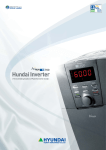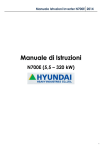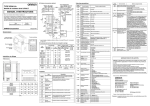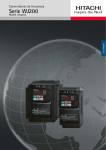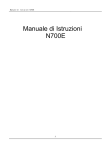Download Hyundai N700E Inverter-Technical Specifications
Transcript
HYUNDAI INVERTER TECHNICAL SPECIFICATIONS Clean Power Hyundai Inverter For the highest quality, for the highest customer satisfaction HYUNDAI N700E series inverter with high durability, exceptional speed control and torque response, providing overall superior Vector Performance. The N700E’s compact size and sensorless vector control technology provide perfectly optimized performance for industrial / commercial equipment. Certificates of international standards (CE, UL/cUL) of N700E series make its applications ready for global business. > Model Name Indication Model Name Indication Model Configuration Applicable motor capacity(kW) 1-Phase, 220V N700E Series name 055 LF R Applicable motor capacity 004 : 0.4kW ~ ~ 055 : 5.5kW ~ ~ 3500 : 350kW Power source SF: 1-Phase, 220V LF: 3-Phase, 220V HF: 3-Phase, 440V Add Option R: DC Reactor Note: DC Reactor option for 30~132kW 0.4 0.7 1.5 2.2 3.7 5.5 7.5 11 15 18.5 22 30 37 45 55 75 90 110 132 160 220 280 350 N700E-004SF N700E-007SF N700E-015SF N700E-022SF 3-Phase, 220V 3-Phase, 440V N700E-004LF N700E-007LF N700E-015LF N700E-022LF N700E-037LF N700E-055LF N700E-075LF N700E-110LF N700E-150LF N700E-185LF N700E-220LF N700E-004HF N700E-007HF N700E-015HF N700E-022HF N700E-037HF N700E-055HF N700E-075HF N700E-110HF N700E-150HF N700E-185HF N700E-220HF N700E-300HF N700E-370HF N700E-450HF N700E-550HF N700E-750HF N700E-900HF N700E-1100HF N700E-1320HF N700E-1600HF N700E-2200HF N700E-2800HF N700E-3500HF Multi-Function High Performance Economical Efficiency Simple Design Easy Operation Contents 03 Features / 04 Specifications / 06 Dimensions / 09 Operations 10 Wiring and Options /13 For Correct Operation ㅣFeaturesㅣ ∷ Improved Control Performance High Torque Performance in Ultra Low Speed Zone by Using Sensorless Vector Control Hyundai’s advanced sensorless vector control technology provides a motor with high torque performance in ultra low speed zone (Sensorless vector control: above 150% at 1Hz). In case of fast acceleration/deceleration of motor, N700E series provides powerful torque controllability without trip. Sensorless vector control technology expands the range of controlling speed. Superb Speed Control Performance by Improved Tuning Technology for Motors Through technology of compensating the motor time constant while motor tuning minimizes the speed change, stable motor opeation can be achieved. Intensified Protective Functions for Safety while Running Ground fault protection can prevent accidents. Countermeasure for output's phase loss protects motor while running. Built-in Regenerative Braking System BRD is basically equipped with the inverter so that the easy operation for acceleration/deceleration time is achieved without additional options. Driving performance of acceleration and deceleration maximizes efficiency. Enhanced Flexibility for Various Loads Built in PID function uniformly controls oil pressure and flow quantity without additional options. Improved torque characteristic, which is reduced to the 1.7th power, perfectly fits with loads for fans and pumps. Optimized energy saving according to the characteristics of loads is achieved. Various Inverter Display Functions The operational status of the inverter are displayed on the monitor so that an user can understand the condition of the inverter. Cumulative hours of driving time and the actual running time are displayed for easy maintenance. Convenient Maintenance and Repair N700E is available to replace the fan without separation. Fan on/off function increases fan's durability and minimizes fan's noise. ㅣSpecificationsㅣ 220V 1-Phase/3-Phase Inverter Model (N700E-□□□□□) 004SF 007SF 015SF 022SF 004LF 007LF 015LF 022LF 037LF 055LF 075LF 110LF 150LF 185LF 220LF Max. Available Heavy Duty motor(4P, kW) Normal Duty 0.4 - - - - - - - - Heavy Duty 1.2 2.1 2.9 4.6 1.2 2.1 2.9 4.6 - - - - - - - - - Rated Capacity(kVA) Normal Duty Rated Input AC Voltage Rated Output Voltage Rated Output Heavy Duty Current(A) Normal Duty Brake Recover Brake Resistance(Ω) Weight(kg) 0.75 1.5 2.2 0.4 0.75 1.5 2.2 3.7 5.5 7.5 11.0 15.0 18.5 - 7.5 11.0 15.0 18.5 22.0 - 7.1 10.0 13.3 18.7 26.6 31.6 37.4 12.5 18.2 24.1 30.3 35.3 - 1-Phase 200~240V±10%, 50/60Hz±5% 3-Phase 200~240V±10%, 50/60Hz±5% 3-Phase 200~240V(Depend on receiving voltage) 3-Phase 200~240V(Depend on receiving voltage) 22.0 3 5 7 11 3 5 7 11 17 24 32 45 64 76 90 - - - - - - - - - 30 44 50 73 85 - Built in Brake Circuit(Need to Additional Brake Resistor) Built in Brake Circuit(Need to additional brake resistor) 50 50 50 50 50 50 50 50 35 17 17 17 8.7 6 6 1.2 1.2 1.5 1.5 1.2 1.2 1.2 1.5 2.0 4.2 4.5 4.5 6.5 7.5 8.0 440V 3-Phase Inverter model (N700E-□□□□□) 004HF 007HF 015HF 022HF 037HF 055HF Max. Available Heavy Duty motor(4P, kW) Normal Duty 0.4 0.75 1.5 2.2 3.7 - - - - - Heavy Duty Rated Capacity(kVA) Normal Duty 1.5 2.8 4 6 - - - - 075HF 110HF 150HF 185HF 220HF 5.5 7.5 11.0 15.0 18.5 22.0 7.5 11.0 15.0 18.5 22.0 30.0 7.6 10.0 13.3 19.1 26.6 31.6 37.4 - 12.5 18.2 24.1 30.7 35.7 47.3 Rated Input AC Voltage 3-Phase 380~480V±10%, 50/60Hz±5% Rated Output Voltage 3-Phase 380~480V(Depend on receiving voltage) Rated Output Heavy Duty Current(A) Normal Duty Brake 1.8 3.4 4.8 7.2 9.2 12 16 23 32 38 45 - - - - - 15 22 29 37 43 57 Built in Brake Circuit(Need to additional brake resistor) Recover Brake Resistance(Ω) Weight(kg) 180 180 180 100 100 70 50 50 30 20 20 1.5 1.5 1.5 1.5 2.0 4.2 4.5 4.5 7.0 7.0 7.5 440V 3-Phase Inverter model (N700E-□□□□□) 300HF 370HF 450HF 550HF 750HF 900HF 1100HF 1320HF 1600HF Max. Available Heavy Duty motor(4P, kW) Normal Duty 30 37 45 55 75 90 110 132 160 220 280 350 37 45 55 75 90 110 132 160 200 250 320 375 Heavy Duty Rated Capacity(kVA) Normal Duty 48.2 62.4 74.8 91.5 123.9 146.3 180.4 216.2 230 315 400 500 58.1 70.1 87.2 112 133 162 191 245 285 360 470 550 3-Phase 380~480V±10%, 50/60Hz±5% Rated Input AC Voltage Rated Output Voltage Rated Output Heavy Duty Current(A) Normal Duty Brake Weight(kg) 2200HF 2800HF 3500HF 3-Phase 380~480V(Depend on receiving voltage) 58 75 90 110 149 176 217 260 300 415 525 656 70 85 105 135 160 195 230 285 370 450 600 680 110 110 170 170 Need to Setup Recover Brake Unit Recover Brake Refer to Option Table (Page 32) Resistance(Ω) 22 22 27 30 50 50 60 60 HYUNDAI INVERTER 03 04 ㅣSpecificationsㅣ Standard 200V, 400V Class Specification Description Space vector PWM method Control Method 1) Output Frequency Range 2) 0.01~400Hz Frequency Accuracy 3) Digital: Max frequency ±0.01% Analogue: Max frequency ±0.1% Frequency Resolution Digital setting: 0.01 Hz (<100Hz), 0.1Hz (>100Hz) Analogue: Max frequency / 500 (when DC 5V input), Max frequency / 1,000 (DC 0~10V, 4~20mA) V/f Characteristic Base frequency: 0~400Hz free set Torque pattern selection available (constant torque / reduced torque) Overload Capacity 150%, 1minute(Heavy Duty), 120%, 1minute(Normal Duty) Acceleration/Deceleration Time 0.1~3,000sec (linear/curve selection available) 2nd Acceleration/Deceleration setting available DC Braking Performs between min frequency and established braking frequency. Level and time setting available Input Output Frequency Standard Operator Setting External Signal Set by volume up/down key. 1W, 1~2kΩ variable resistor. DC 0~10V (input impedance 10kΩ), 4~20mA (input impedance 250Ω). Forward Reverse Start/Stop Standard Operator Run key / Stop key (change forward/reverse by function command). External Signal Forward run/stop, reverse run/stop set by terminal assignment (1a, 1b selection available) Intelligent Input Terminal FW (Forward), RV (Reverse),CF1~4 (Multi-speed), RS (Reset), AT (Analog input current / voltage Transfer), USP (Unattended Start Protection), EXT (External Trip), FRS (Free Run Stop), JG (Jogging Command), SFT (Software Lock Command), 2CH (2nd Acceleration/Deceleration), SET (2nd Motor Constants Setting) Intelligent Output Terminal RUN (Run Signal), FA1 [Frequency Arrival Signal (at the set frequency)], FA2 [Frequency Arrival Signal (at or above the set frequency)], OL (Overload Advanced Notice Signal), OD (Output Deviation of PID Signal), AL (Alarm Signal) Frequency Monitor Analog meter (DC0~10V full scale. Max. 1mA) Analog output frequency signal and analog output current signal Analog output voltage signal selection available. Alarm Output Contact OFF when inverter alarm (b contact output) / Auto switch ON and OFF / Intelligent output terminal use available Main Functions Auto-tuning, AVR Function, V/F Setting, Curve Accel./Decel. Selection, Frequency Upper/Lower Limit, 6 Level Multi-speed, Start Frequency Set, Carrier Frequency Setting (0.5~15kHz), PID Control, Frequency Jump, Analog Gain Bias Control, Jogging Run, Electronic Thermal Level Control, Retry, Auto Torque Boost, Trip History Monitor, Software Lock, S-shape Accel./Decel., Frequency Conversion Display, USP, 2nd Control Protective Functions 4) Over-current Protection, Overload (electronic thermal), Over-voltage, Communication Error, Under-voltage, Output Short, USP Error, EEPROM Error, External Trip, Ground Fault, Temperature Trip Environmental Conditions Options Ambient Temperature -10~50°C (over 40°C: set carrier frequency below 2.0kHz) Storage Temperature -20~60°C (while transporting: short time) Ambient Humidity Below 90%RH (non-condensing) Vibration 5.9m/s2 (0.6G). 10~55Hz (JIS C0911 test methodology) Location Less than 1,000m above sea level, Indoor (no corrosive gas, no flammable gas, no oil-drop, no-dust) Noise filter, DC reactor, AC reactor, Remote operator, Remote operator cable, Regenerative braking resistor ※ 1) Before control method setting A31 is set to 2 (sensorless vector control), the following instructions should be considered. - Carrier frequency setting b11 should be above 2.1kHz. - When you use motors below half capacity of max applicable motor capacity, it is hard to get sufficient quality. - When over 2 motors are about to be operated, sensorless vector control cannot be applied. 2) When you operate motor over 50/60Hz, inquire about maximum available rotational number. 3) For the purpose of stable motor control, output frequency can exceed approximately 1.5kHz at [A04] 4) Protective method is based on JEM1030. ㅣDimensionsㅣ N700E-004SF/007SF, N700E-004LF/007LF/015LF N700E-015SF/022SF, N700E-022LF, N700E-004HF/007HF/015HF/022HF [Unit:mm] [Unit:mm] N700E-005LF/055HF, N700E-075LF/075HF, N700E-110LF/110HF N700E-037LF/HF [Unit:mm] [Unit:mm] HYUNDAI INVERTER 05 06 ㅣDimensionsㅣ N700E-150LF/150HF, N700E-185LF/185HF, N700E-220LF/220HF N700E-300HF, N700E-370HF [Unit:mm] N700E-450HF, N700E-550HF [Unit:mm] N700E-750HF, N700E-900HF [Unit:mm] [Unit:mm] ㅣDimensionsㅣ N700E-1100HF, N700E-1320HF N700E-1600HF, N700E-2200HF [Unit:mm] [Unit:mm] N700E-2800HF, N700E-3500HF [Unit:mm] HYUNDAI INVERTER 07 08 ㅣOperationsㅣ Operations PRG LED RUN LED This LED is on when the inverter is ready for parameter editing. ▲ On when the inverter outputs the PWM voltage and operating command is ready. ▲ ▲ Hz LED / A LED Shows whether the display is reading Hz or Amps. ▲ POWER LED ▲ On when the control power input to the inverter is on. LED DISPLAY STOP / RESET KEY Used for stopping the motor or resetting errors. (When either operator or terminal is selected, this key works. If the extension function B15 is used, this function is void.) ▲ Displays frequency, motor current, motor rotation speed, alarm history and setting value. ▲ RUN KEY ▲ Starts the motor and inverter. RUN key is disabled when the inverter is selected to run by control terminal input. RUN key is available only while the above LED is on. POTENTIOMETER Sets the inverter to output frequency. ▲ FUNCTION KEY ▲ ▲ Used for changing parameter and command. ▲ STORE KEY UP / DOWN KEY Press the STORE KEY save the data and set value to memory. Increase/decrease frequency value and modify set values Standard Operator Setting 0.0 d 01 Push FUNC key once Push key 5 times 0 01 Store data by pushing STR key 0.0 01 Push FUNC key once A 01 060.0 Push key 9 times 01 Push key 4 times F Store data by pushing STR key 060.0 Push FUNC key once -- Push FUNC key once Set frequency by pushing key d Push FUNC key once A Display Running Frequency F 01 Push FUNC key once A 2 Push key twice F A -- Displays current running frequency 01 Start inverter by pushing RUN key ㅣWiring and Optionsㅣ Wiring and Options The sensitivity of circuit breaker (MCCB) should be differentiated by the sums of wiring distances (inverter-power supply and inverter-motor). Wiring Distance Sensitive Current(mA) Under 100m 50 Under 300m 100 ※ Applied wiring equipment represents HYUNDAI 3-phase 4-poles motor. ※ Braking capacity should be considered for circuit breaker. ※ When wiring distance is over 20m, there is need to apply large power cable. ※ Use circuit breaker (MCCB) for safety. ※ Do not perform ON/OFF function of electromagnetic contactor while inverter is in normal operating condition. ※ Use 0.75mm2 for alarm output contact. ※ When wiring with metal tube using CV line, there exists 30mA/km current. ※ IV line has high non-dielectric constant : current increases 8 times. Therefore, 8 times greater sensitivity current , as shown in the table above, should be applied. When wiring distance is over 100m, use CV line. ※ ON/OFF operation is prohibited at the output side by using electromagnetic contactor. when it is necessary to apply electromagnetic contactor at the output side by using bypass circuit, protective circuit that prevents electromagnetic contactor from operating ON/OFF function should be applied while inverter is in normal operation. Order Function Name Input-side AC Reactor (1) (Harmonic Control, Electrical Coordination, Powerfactor Improvement) Description As a measure of suppressing harmonics induced on the power supply lines, it is applied when imbalance of the main power voltage exceeds 3% (and power source capacity is more than 500kVA), or when the power voltage is rapidly changed. It also improves the power factor. This reduces common noise that is generated between input power and ground. Connect this filter to 1st side (input side) of inverter. (2) Noise Filter for Inverter (3) Radio Noise Filter (4) Input Radio Noise Filter This reduces radiated noise from Input power wirings. (5) DC Reactor Suppresses harmonics generated by the inverter (6) Output-side Noise Filter This reduces radiated noise from wiring in the inverter output side. This also reduces wave fault to radio and TV, and it is used for preventing malfunction of sensor and measuring instruments. (7) (8) (9) (Zero-phase Reactor) Radio Noise Filter (0-phase Reactor) Electrical noise interference may occur on nearby equipment such as a radio receiver. This magnetic choke filter helps reduce radiated noise (can also be used on output). Electrical noise interference may occur on nearby equipment such as a radio receiver. This magnetic choke filter helps reduce radiated noise (can also be used on input). Output AC Reactor to Reduce Vibration and Prevent Thermal Relay Misapplication This reactor reduces the vibration in the motor caused by the inverter’s switching waveforms, by smoothing the waveforms to approximate commercial power quality. When wiring from the inverter to the motor is more than 10m in length, inserting a reactor prevents thermal relay’s malfunction by harmonic generated by inverter’s high switching. LCR Filter Sine-wave shaping filter for the output side. HYUNDAI INVERTER 09 10 ㅣWiring and Optionsㅣ Brake Resister Voltage Inverter Model Light Load Model Name Resistor(Ω) RB-00P3-50 50.0 N700E-022SF/LF RB-00P3-50 N700E-037LF RB-00P6-35 Heavy Load Model Name Resistor(Ω) Capacity(kW) 0.3 RB-00P3-50 50.0 0.3 50.0 0.3 RB-00P6-35 35.0 0.6 35.0 0.6 RB-01P2-35 35.0 1.2 Capacity(kW) Brake Unit N700E-004SF/LF N700E-007SF/LF N700E-015SF/LF 200V Default Inclusion N700E-055LF N700E-075LF RB-01P0-17 17.0 1.0 RB-01P2-17 17.0 1.2 N700E-150LF RB-02P5-8.7 8.7 2.5 RB-04P5-8.7 8.7 4.5 N700E-185LF RB-03P0-6 6.0 3.0 RB-05P6-6 6.0 5.6 N700E-220LF RB-04P0-6 6.0 4.0 RB-06P6-6 6.0 6.6 RB-00P3-180 180.0 0.3 RB-00P3-180 180.0 0.3 N700E-022HF RB-00P3-100 100.0 0.3 RB-00P6-100 100.0 0.6 N700E-037HF RB-00P6-100 100.0 0.6 RB-00P6-100 100.0 0.6 N700E-055HF RB-01P2-70 70.0 1.2 RB-01P8-70 70.0 1.8 N700E-075HF RB-01P2-50 50.0 1.2 RB-02P4-50 50.0 2.4 N700E-110HF RB-02P0-50 50.0 2.0 RB-03P3-50 50.0 3.3 N700E-150HF RB-02P5-30 30.0 2.5 RB-04P5-30 30.0 4.5 N700E-185HF RB-03P0-20 20.0 3.0 RB-05P6-20 20.0 5.6 N700E-220HF RB-04P0-20 20.0 4.0 RB-06P6-20 20.0 6.6 N700E-300HF RB-05P0-12 12.0 5.0 RB-09P0-12 12.0 9.0 N700E-370HF RB-06P0-12 12.0 6.0 RB-11P2-12 12.0 11.2 N700E-450HF RB-07P0-8 8.0 7.0 RB-13P5-8 8.0 13.5 N700E-550HF RB-08P5-8 8.0 8.5 RB-16P5-8 8.0 16.5 N700E-750HF RB-11P2-6 6.0 11.2 RB-22P5-6 6.0 22.5 RB-11P2-6 (x2) 6.0 (x2) 11.2 RB-22P5-6 (x2) 6.0 (x2) 22.5 RB-22P5-3 (x2) 3.0 (x2) 22.5 RB-45P0-3 (x2) 3 45.0 RB-33P7-2 (x2) 2.0 (x2) 33.7 RB-67P5-3 (x2) 2 67.5 N700E-110LF N700E-004HF N700E-007HF N700E-015HF 400V N700E-900HF N700E-1100HF Option N700E-1320HF N700E-1600HF N700E-2200HF N700E-2800HF N700E-3500HF Default Inclusion ㅣWiring and Optionsㅣ Brake Resistor Drawing / Size ■ A TYPE : RB-01P0 ~ RB-02P0 ■ B TYPE : RB-02P4 ~ RB-22P5 A TYPE L1 L2 L3 RB-01P0 340 385 302 495 362 RB-01P2 400 RB-01P8 ~ RB-02P0 510 B TYPE L1 W1 W2 H 70 39 45 472 W1 W2 H RB-02P4 ~ RB-02P5 180 140 126 RB-03P0 260 220 126 RB-04P0 ~ RB-05P6 180 140 182 260 220 182 260 220 340 300 RB-06P6 RB-08P0 ~ RB-09P0 RB-11P2 ~ RB-13P5 550 L2 530 L3 503 252 RB-22P5 322 392 RB-16P5 392 ■ C TYPE : RB-00P3 ■ D TYPE : RB-00P6 ■ E TYPE : RB-01P2 HYUNDAI INVERTER 11 12 ㅣFor Correct Operationㅣ ✽Before use, be sure to read through the Instruction manual to insure proper use of the inverter. ✽Note that the inverter requires electrical wiring; a trained specialist should carry out the wiring. ✽The inverter in this catalogue is designed for general industrial applications. For special applications in fields such as aircraft, nuclear power, transport, vehicles, clinics, and underwater equipment, please consult us in advance. ✽For application in a facility where human life is involved or serious losses may occur, make sure to provide safety devices to avoid a serious accident. ✽The inverter is intended for use with a three-phase AC motor. For use with a load other than this, please consult with us. Application to Motors | Application to General-purpose Motors Operating Frequency The overspeed endurance of a general-purpose motor is 120% of the rated speed for 2minutes (JIS C4004). For operation at higher than 60Hz, it is required to examine the allowable torque of the motor, useful life of bearings, noise, vibration, etc. In this case, be sure to consult the motor manufacturer as the maximum allowable rpm differs depending on the motor capacity, etc. Torque Characteristics The torque characteristics of driving a general-purpose motor with an inverter differ from those of driving it using commercial power (starting torque decreases in particular). Carefully check the load torque characteristic of a connected machine and the driving torque characteristic of the motor. Motor Loss and Temperature Increase An inverter-driven general-purpose motor heats up quickly at lower speeds. Consequently, the continuous torque level (output) will decrease at lower motor speeds. Carefully check the torque characteristics and speed range requirements. Noise When run by an inverter, a general-purpose motor generates noise slightly greater than by commercial power. Vibration When run by an inverter at variable speeds, the motor may generate vibrations, especially because of (a) unbalance of the rotor including a connected machine, or (b) resonance caused by the natural vibration frequency of a mechanical system. Particularly, be careful of (c) when a machine previously fitted with a constant speed is operated at variable speed. Vibration can be minimized by (1) avoiding resonance points by using the frequency jump function of the inverter, (2) using a tireshaped coupling, or (3) placing a rubber shock absorber under the motor base. Power Transmission Mechanism Under continued, low-speed operation, oil lubrication can deteriorate in a power transmission mechanism with an oil type gear box (gear motor) or transmission. Check with the motor manufacturer for the permissible range of continuous speed. To operate at more than 60Hz, confirm the machine’s ability to withstand the centrifugal force generated. Application to Motors | Application to Special Motors Gear Motor The allowable rotation range of continuous drive varies depending on the lubrication method or motor manufacturer (Particularly in case of oil lubrication, pay attention to the low frequency range). Grease lubrication has no degradation of lubrication ability even when the number of rotation decreases (Allowable frequency range: 6~120Hz). Brake-equipped Motor For use of a brake-equipped motor, power supply for braking operation should be separately prepared. Connect the braking power supply to the primary side power of the inverter. Use brake operation (inverter stop) and free run stop (FRS) terminal to turn off inverter power. Pole-change Motor There are different kinds of pole-change motors (constant output characteristic type, constant torque characteristic type, etc.), with different rated current values. In motor selection, check the maximum allowable current for each motor of a different pole count. At the time of pole change, be sure to stop the motor. Submersible Motor The rated current of a submersible motor is significantly larger than that of the general-purpose motor. In inverter selection, be sure to check the rated current of the motor. Explosion-proof Motor Inverter drive is not suitable for a safety-enhanced explosion-proof type motor. The inverter should be used in combination with a pressure-proof and explosion-proof type of motor. 。リ Explosion-proof verification is not available for N700E series. Synchronous (MS) Motor / High-speed (HFM) Motor In most cases, the synchronous (MS) motor and the high-speed (HFM) motor are designed and manufactured to meet the specifications suitable for a connected machine. As to proper inverter selection, consult the manufacturer. Single-phase Motor A single-phase motor is not suitable for variable-speed operation by an inverter drive. Therefore, use a three-phase motor. Application to Motors | Application to the 400V-class Motor A system applying a voltage-type PWM inverter with IGBT may have surge voltage at the motor terminals resulting from the cable constants including the cable length and the cable laying method. Depending on the surge current magnification, the motor coil insulation may be degraded. In particular, when a 400V class motor is used, a longer cable is used, and critical loss can occur. Take the following countermeasures : (1) install the LCR filter between the inverter and the motor,(2) install the AC reactor between the inverter and the motor, or (3) enhance the insulation of the motor coil. Notes on Use | Drive Run/Stop Run or stop of the inverter must be done with the keys on the operator panel or through the control circuit terminal. Installing an electromagnetic contactor (Mg) should not be used as a switch of run/stop. Emergency Motor Stop When the protective function is operating or the power supply stops, the motor enters the free run stop state. When emergency stop or protection of motor is required, use of a mechanical brake should be considered. High-frequency Run N700E series can be set up to 400Hz. However it is extremely dangerous for rotational speed of two-pole motor to reach up to approx 24,000rpm. Therefore, carefully make selection and settings after checking the mechanical strength of the motor and connected machines. Consult the motor manufacturer when it is necessary to drive a standard (general-purpose) motor above 60Hz. ㅣFor Correct Operationㅣ Notes on Use | Installation Location and Operating Environment Avoid installation in areas of high temperature, excessive humidity, or easy condensation of dew, as well as areas that are dusty, subject to corrosive gases, residue of grinding solution, or salt. Install the inverter away from direct sunlight in a well-ventilated room that is free of vibration. The inverter can be operated in the ambient temperature range from -10°C to 50°C Notes on Use | Main Power Supply In the following examples involving a general-purpose inverter, a large peak current flows on the main power supply side, and could destroy the converter module. When such situations are predictable or connected crucial device is required to meet high reliability, install an AC reactor between the power supply and the inverter. Also, when influence of indirect lightning strike is possible, install a lightning arrester. Installation of an AC reactor on the Input Side A) The unbalance factor of the power supply is 3% or higher1.1) B) The power supply capacity is at least 10 times greater than the inverter capacity (the power supply capacity is 500kVA or more). C) Abrupt power supply changes are expected. Examples) ① Several inverters are interconnected with a short bus. ② A thyristor converter and an inverter are interconnected with a short bus. ③ Junction and disjunction of installed phase advance capacitor. In cases (A), (B) and (C), it is recommended to install an AC reactor on the main power supply side. 1) Example of how to calculate voltage unbalanced ratio. (voltage between lines on RS: VRS=205V, voltage between lines on ST : VST=201V, voltage between lines on TR: VTR=200V), max voltage between lines-average between lines= VRS-(VRS+VST+VTR)/3=205-202 ·Voltage unbalanced ratio = Using an Independent Electric Power Plant Max. voltage between lines - Average voltage between lines VRS-(VRS+VST+VTR)/3 205-202 ×100 = ×100 =100 = 1.5(%) × Average voltage between lines (VRS+VST+VTR)/3 202 If an inverter is run by an independent electric power plant, harmonic current can cause to overheat the generator or distort output voltage waves of the generator. Generally, the generator capacity should be five times that of the inverter (kVA) in a PWM control system, or six times greater in a PAM control system. Notes on Peripheral Equipment Selection Wiring Connections Electromagnetic Contactor Wiring between Inverter and Thermal Relay Motor Installing a Circuit Breaker (1) Be sure to connect main power wires with R (L1), S (L2), and T (L3) (input) terminals and motor wires to U (T1), V (T2), and W (T3) terminals (output). (Incorrect connection will cause an immediate failure.) (2) Be sure to provide a grounding connection with the ground terminal( ) When an electromagnetic contactor is installed between the inverter and the motor, do not perform on-off switching during running. When used with standard output motors (standard three-phase squirrel cage four pole motors), the N700E series does not need a thermal relay for motor protection due to the internal electronic protective circuit. A thermal relay, however, should be used: during continuous running out of a range of 30Hz to 60Hz for motors exceeding the range of electronic thermal adjustment (rated current). When several motors are driven by the same inverter, install a thermal relay for each motor. The RC value of the thermal relay should be more than 1.1times the rated current of the motor. Where the wiring length is 10m or more, the thermal relay tends to turn off readily. In this case, provide an AC reactor on the output side or use a current sensor. Install a circuit breaker on the main power input side to protect inverter wiring and ensure personal safety. Choose a circuit breaker compatible with inverter. Wiring Distance The wiring distance between the inverter and the remote operator panel should be 20meters or less. When this distance is exceeded, use CVD-E (current-voltage converter) or RCD-E (remote control device). Shielded cable should be used on the wiring. Beware of voltage drops on main circuit wires (A large voltage drop reduces torque). Earth Leakage Relay If the earth leakage relay (or earth leakage breaker) is used, it should have a sensitivity level of 15mA or more (per inverter). Leakage current is depending on the length of the cable. Phase Advance Capacitor Do not use a capacitor for improvement of power factor between the inverter and the motor because the high-frequency components of the inverter output may overheat or damage the capacitor High-frequency Noise and Leakage Current (1) High-frequency components are included in the input/output of the inverter main circuit, and they may cause interference in a transmitter, radio, or sensor if used near the inverter. The interference can be minimized by attaching noise filters (option) in the inverter. (2) The switching of an inverter causes an increase of leakage current. Be sure to ground the inverter and the motor. Lifetime of Primary Parts Because a DC bus capacitor deteriorates as it undergoes internal chemical reaction, it should normally be replaced every five years. Be aware, however, that its life expectancy is considerably shorter when the inverter is subject to such adverse factors as high temperatures or heavy loads exceeding the rated current of the inverter. The figure at the right shows the approximate lifetime of the capacitor when it is used 24hours. Also, such moving parts as a cooling fan should be replaced. Maintenance, inspection and replacing parts must be performed by only specified professional engineers. HYUNDAI INVERTER 13 14 United States Motor and Inverter Representative WorldWide Electric Corporation Warehouse Locations Allentown, PA / Atlanta, GA / Dallas, TX / Indianapolis, IN / Kansas City, KS Little Rock, AR / Los Angeles, CA / Miami, FL / Rochester, NY * Available For Pick-Up Or Delivery 24 Hours A Day - 7 Days A Week Sales Offices Atlanta, GA / Boston, MA / Chicago, IL / Denver, CO / Detroit, MI Los Angeles, CA / Miami, FL / Mobile, AL / Rochester, NY / St. Louis, MO Rochester, NY Detroit, MI Chicago, IL Denver, CO Boston, MA Allentown, PA Kansas City, KS Los Angeles, CA Indianapolis, IN Little Rock, AR St. Louis, MO Atlanta, GA Dallas, TX Mobile, AL Miami, FL WorldWide Electric Corporation P.O. Box 307, Pittsford, NY 14534 USA Tel: 800-808-2131 Fax: 800-711-1616 www.worldwideelectric.net Head Office 1, Jeonha-dong, Dong-gu, Ulsan, Korea Tel: 82-52-202-8527~8, 8681~2 Fax: 82-52-202-8520 Seoul (Sales & Marketing) 140-2, Gye-dong, Jongno-gu, Seoul, Korea Tel: 82-2-746-7515, 7627 Fax: 82-2-746-7679

















